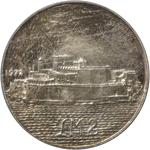1st series - Fort St Angelo
|
1972
|
|
1st series - Fort St Angelo
|
|

|
|
The first documented mention of a Castrum Maris (castle by the sea) on the tip of the Vittoriosa peninsula goes back to the 1240s. In the 1270s the castle had a garrison of 150 men and included two chapels, which are still in place.
The Order of St John took over Malta in 1530 and the knights settled in Vittoriosa, then a small maritime village. The castle became the residence of the Grand Master. Various modifications were made to strengthen the old medieval castle. A bastion was built by De Homedes to buttress the land front while the ditch was deepened and turned into a moat. A cavalier was built to dominate its surroundings and a sea-level battery was constructed. These modifications enabled the fort to successfully resist the Ottoman siege of 1565 during the course of which it also repulsed a sea-borne attack on Senglea. Fort St Angelo dates back to the late 17th Century, when the military engineer Carlo Grunenberg designed and financed the building of four tiered batteries, which overlook the entrance to the Grand Harbour.
When Malta became a British colony, the British Army took over Fort St Angelo. In 1912 the fort became the headquarters of the Royal Navy's Mediterranean Fleet. At the time it was known as HMS Egmont, but from 1933 it became known as HMS St Angelo. The fort was handed over to the Maltese Government in 1979.
|
|
Type
|
Denomination
|
Diameter (mm)
|
Gross Weight (g)
|
Finesse
|
Designer
|
Mint
|
Mintage
|
|
Silver
|
Lm2
|
38
|
20
|
0.987
|
Pietro Giampaoli
|
SMOM, Rome
|
|